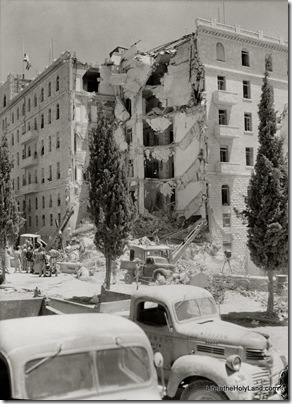One of my side interests that I’ve not pursued much beyond occasional reading is the history of the land of Israel in the 20th century. This includes the time of the British Mandate and the birth of the state of Israel. My photo projects have always been aligned with courses I have taught—namely, the subjects of historical geography and archaeology, both inside and outside the land of Israel. But as I worked on the creation of photo collections from the American Colony, I saw a worthy set of photos about this important period of history. Thus the Early 20th-Century History CD strays beyond the bounds of “Bible places,” but many, like me, find that their interest in biblical history naturally leads to the dramatic events of recent years.
One reason for this interest is simply that these realities are part of your world when you’re in Israel and Jerusalem in particular. Zion Gate is of interest not only because it leads to Mount Zion with the “tomb of David” and “Upper Room,” but also because of its pockmarked exterior caused by fighting in the War of Independence of 1948. Everything has a story, and these stories explain why things are the way they are.
One story I’ve heard and repeated came more to life for me when I saw the photo below. The King David Hotel was bombed by Jewish terrorists in 1946 and ninety-two people were killed. The hotel was quickly rebuilt and no signs (that I know of) exist. I always had trouble envisioning it, and understanding what was meant that a “wing” of the hotel was destroyed.
Rather than describe the story myself, I prefer to quote a brief portion from Martin Gilbert’s wonderful book, Jerusalem in the Twentieth Century. If you have any interest in Jerusalem itself, or in the modern history of Israel, I highly recommend this book. Gilbert writes:
Hatred of the British had been inflamed among these two groups [Irgun and Stern Gang] by the refusal of the British to allow survivors of the concentration camps into Palestine. The Jewish terrorists, who included two future Israeli Prime Ministers, Menachem Begin and Yitzhak Shamir, believed that by “blood and fire” they could drive the British out of the country, and establish a Jewish State. Their most devastating attack was made on 22 July 1946, when members of the Irgun, disguised as Arabs, brought explosive charges in milk-churns into the hall outside the Regence Cafe in the basement of the King David Hotel. Above the cave, the south wing of the hotel, five floors in all, was being used as the British administrative headquarters. An anonymous woman telephoned the switchboard operator at the hotel to say that the hotel must be evacuated as there would be an explosion “in a few minutes.” Her warning was ignored.
At 12.37 the explosives went off. Five floors and twenty-five rooms collapsed into rubble. Ninety-two persons in the wing were killed: Britons, Arabs and Jews. Among the dead were military and civilian officials, soldiers, clerks, typists, cleaners, drivers and messengers. The British dead included the Postmaster-General of Palestine, G. D. Kennedy, a veteran of the retreat from Mons in 1914. One of the Arabs killed, Jules Gress, a senior assistant accountant with the Secretariat, was a Catholic. He had been an officer in the Turkish army in the First World War, when he was taken prisoner by the British. While at his bank that morning he had asked to be served quickly, so as not to be late for a Secretariat meeting. Commented the Palestine Post: “He hurried back to his duty and his death.”
[…]
The Jewish Agency denounced what it called “the dastardly crime” perpetrated by a “gang of desperadoes,” and called upon the Jews of Palestine “to rise up against these abominable outrages” (172-73).
If, like me, you knew only sketches of the story, perhaps now the picture is clearer.

5 thoughts on “Bombing of King David Hotel (1946)”
Todd, you mentioned that "no signs…exist." While the hotel may show no signs of destruction, last spring I photographed a sign outside the King David hotel that documents the attack.
d. miller's link to "a sign" erroneously leads simply to blogger.com.
That's odd. Here's the url: http://gervatoshav.blogspot.com/2010/03/who-invented-terrorism.html
David – thanks for the photo. I don't remember seeing this sign.
This was not a "terrorist attack." It was not aimed at civilians, and ample warning was given to leave the building. This wing of the hotel was being used as the British Army headquarters. The attack was aimed at the military and not civilians. And again, warning was given. But the British were too proud to leave the building. They felt the warning was a false one designed to make them look stupid by evacuating the building when there was no need to do so. Well, they proved their stupidity by refusing to leave.